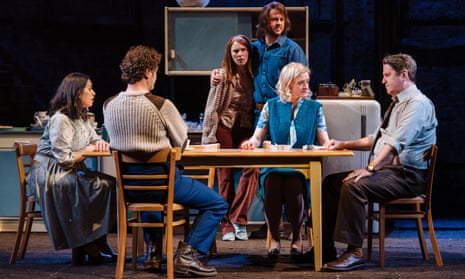Old myths die hard. One of the greatest in theatre is that the large-scale play that unites public issues and private lives is the special province of male dramatists. Watching Beth Steel’s The House of Shades at the Almeida, I was reminded that this is a ludicrous fallacy: seeing The Father and the Assassin by Anupama Chandrasekhar shortly after at the Olivier, it struck me that female writers are, if anything, currently in the vanguard when it comes to recording social divisions, political antagonisms and questions of national identity.
You can trace the growth of this commitment to public issues back to a work such as Votes for Women by Elizabeth Robins, which in 1907 passionately advocated female suffrage. In our own times Caryl Churchill has explored the inter-connection of socialism and feminism, Lucy Kirkwood in Chimerica (2013) examined the complex relationship between the world’s two greatest powers and Lucy Prebble’s A Very Expensive Poison (2019) exposed British vacillation in the face of Russian corruption. Beth Steel herself probed the unhealed scars left by the miners’ strike of 1984 in Wonderland (2014) .
Now, in The House of Shades, Steel has gone even further by dramatising the changing face of Britain between 1965, when Harold Wilson’s Labour government was in power, and 2019 when the Conservatives enjoyed an electoral triumph. Her method is to follow the fortunes of one particular working-class family and, in particular, to focus on the way women, down the generations, have paid the price for social and political failure.

Constance, the pivotal figure, fiercely resents her lack of a grammar-school education and escapes into showbiz fantasies. Her socialist daughter, Agnes, is angry at the way women are employed in what she calls part-time “piss-pot jobs” because they are cheaper. The pay-off comes in 2019 when Agnes’s own daughter, accusing the Labour party of encouraging mass immigration, betrays her roots by voting Tory.
Critics have pointed out Steel’s debt to Greek tragedy but I was more impressed by her reliance on a deeply English cultural inheritance. It is surely no accident that her play opens with the meticulous washing of a corpse and reminds one of The Widowing of Mrs Holroyd by a fellow Nottinghamshire writer, DH Lawrence. Constance’s husband, more devoted to his shop-steward duties than domestic strife, is similar to a character played by John Mills in a 1961 British movie, Flame in the Streets. Agnes’s diatribe about the neglect of those who do society’s dirty jobs directly echoes a speech in David Hare’s Skylight attacking the “rightwing fuckers” who sneer at those who deal with the mess others have created. The abortion, which is central to Steel’s plot, also brings to mind a raft of movies including Mike Leigh’s Vera Drake.
You could argue that Steel tries to do too much; but better that than too little. Without mentioning the word “Brexit” or “red wall seats”, she goes a long way towards explaining why swathes of the north and Midlands swung to the right at the 2019 election. She is also very good on detail: the working-class father who in 1965 reads both the Daily Mirror and books at the dinner table is as plausible as the son who moves from adolescent communism to adult entrepreneurship. Having lived through all the events Steel describes, my only cavil is that she underplays the optimism that followed Wilson’s electoral victory in 1965 and that in 1996 anticipated Blair’s triumph at the polls the following year.
Disillusion may ultimately have set in but in both the Wilson and Blair eras there was talk of a new dawn. My vantage point, as a middle-class metropolitan male, is however, wholly different from that of Steel and I respect the authenticity of her portrait of the east Midlands working class. All I can say is that her play is a work of enormous zest and zeal that shows theatre fulfilling its historic function of explaining the British to themselves.

